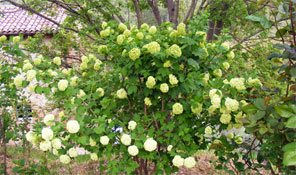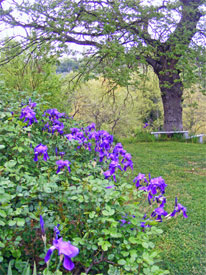
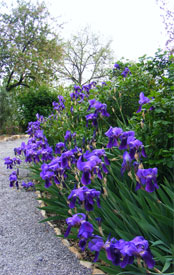
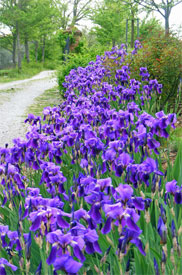
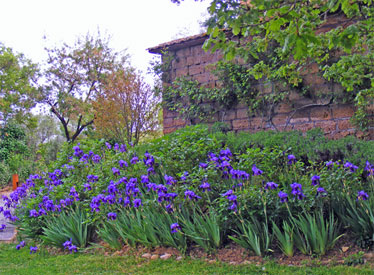
CdP
26 April 2013
We were in Rome earlier in the week. The city was looking rather splendid and, because it rained heavily just as I arrived, smelling relatively nice too. There are surprising orange trees in odd places in Testaccio, where our apartment is. You can’t always see them. But you certainly can smell them, especially on warm days right after a heavy shower of rain.
As I stepped out of my car, which I had parked by the extremely high wall of the technical school one block over, with no greenery except the poor beleaguered Tiber-side planes in view, the perfume of orange blossom was overwhelming. I suppose it must have been coming from inside the school yard. Superb.
There are two plants in Rome which alone are worth a pilgrimage. Firstly there’s the wisteria over the pergola that runs up the seemingly destination-less flight of steps between the steps to the Capitoline and those to the Ara Coeli church. There’s a little statue there of Cola di Rienzo, the tribune-rabble-rouser of 14th-century Rome. And a river of dense blue wisteria flowers for just a few precious weeks of the year.
Then there’s the Cercis siliquastrum that spreads its huge canopy up the slope on the via di San Gregorio side of the Palatine hill. It’s a magnificent beast, an impenetrable forest of the purplest blossom.
I make a point of paying homage to both each spring. On this visit, however, something went awry. Zipping past below the Campidoglio on a crowded bus, I noticed an incongruous mass of white overlaying the blue of the wisteria. Was it white wisteria? Or had something else – the dreaded Fallopia baldschuanica (Russian vine) perhaps – made its unwelcome way in there? I was in too much of a hurry to stop and investigate. Whatever it was, it was sadly out of place.
As for the Palatine Judas Tree, well: I was too busy gossiping to take it in. I was giving a friend a lift home and had already passed it by before I realised my mistake. Will I return before all those buds meet the same fate of the ones now carpeting the pavements of the whole Testaccio district? Probably not.
Romans, I observed on this visit, are changing in fundamental ways – ways that use to define them as Romans. Until not so many years ago, pulling up to a red light at a big intersection before anyone else – finding yourself in pole position for when the light turned green – could be a daunting experience. A row of wild-eyed drivers would revv up loudly, shooting each other challenging glances, jockeying for position in a clutch-control ballet, ready to scream off a split second ahead of all the others to avoid being the object of the ire of furiously beeping ranks behind.
This time I pulled up in the front row by the Stadio Olimpico and was soon joined by dozens of others. No jockeying, no eyeing. And when the lights turned green, no movement. I inched forward then worried that I had mis-seen, checked the lights (green) then stared at my neighbours: five of them – one to my left, four to my right – all texting. Gradually the horn chorus began behind, but only many seconds after we had a green. Presumably their attention had been aroused by the one driver-hooter who had left his smartphone at home and was rushing back to get it.
But ultimately Rome does, despite changes, remain resolutely Fellinian. Standing on the lungotevere waiting for the bus, I watched as a man clattered by on the river-side pavement opposite, deftly negotiating the bulging tree roots on his rackety old bike. He was a black man, in an unbuttoned checked shirt that was flapping against him, and he was riding hand-less, playing a tune on a melodica.
Back at the ranch, it’s a rush to get pre-spring things completed before spring swamps us totally. We were up at an unthinkable hour (for us) this morning, burning off piles of Arundo donax chopped down over the winter but never dry enough to set fire to, of clippings from the olive trees which were pruned yesterday, and of debris from that funny apple tree clump slap bang in the middle of the field which we cleared out gradually over a series of sunny winter days.
As I ploughed back and forth between my smoking piles, the grass in the wetter parts of the field (and so much of it is still soaking) came up to my thigh. Were it not quite so full of wild orchids and Ornithogalum (Star of Bethlehem) then I would try to get someone in now to mow it. But it is, so I won’t. There’s one magnificent orchid sticking straight up out of the middle of the gravel filling in one of the stairs running down beneath the big field maple. It’s standing there defiantly, as if to say “you built your stairs here, but this is my spot so go round me.” It’s magnificent.
My potatoes – abandoned so long in the bathtub in the bathroom upstairs because the ground was just to wet and soggy to plant them – are now pushing their leaves up through the soil. Phew. I was beginning to think I may have lost them. On one of my anxious inspections two days ago, I found an immense grass snake resting on top of the channels where the potatoes should have been, its head poking through the very small-gauge netting that I put up around that bit of the garden to keep hungry boar and deer out of my veg in the winter. It was lying quite still – and I was high-tailing it quite swiftly – so I was unable to tell whether it was just resting, or whether it had managed to manoeuvre itself in but was now stuck in there for good. I now think the latter. Because when I went back the next morning, that whole side of the plastic netting had been ripped to shreds. No sign of the snake.
I see that by this time last year I had already launched my anti-ant offensive. This year, I can’t quite work out what they’re up to. The little buggers started appearing just before our last big downpour. Then they disappeared: one or two here and there, but nothing like the full-scale surge we usually get mid-April. Every morning I scour ground and house walls but they really aren’t moving yet. But I’m not getting my hopes up. They will come. Inevitably.
